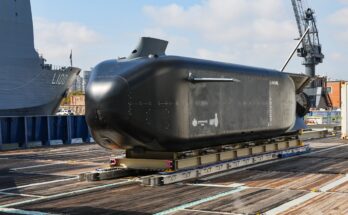
Apache AH 64E in the Arizona Desert. Image – The Boeing Company
BAE Systems has been one of the pre-eminent suppliers of airborne identification friend or foe (IFF) systems to the U.S. armed services for years. IFF systems such as the APX-111, APX-125, and APX-126 fly aboard a gargantuan fleet of critical fighter assets such as the F-16 and F-18 series. Production of another of the company’s most broadly utilized IFF systems, though, the APX-123 (aka the Common Transponder, or CXP) could be coming to an end.
Among the list of platforms for which the APX-123 provides crucial IFF services are the AH-64, CH-47, CH-53, E-2, H-1 series, H-60/S-70 series, P-3, and V-22 series. The APX-123 even serves on board the U.S. presidential helicopter.
Some facts about the APX-123: The APX-123’s usage spans multiple U.S. service branches, including the Army and Navy; the number of aircraft now flying with the APX-123 counts well into the multiples of thousands; and the number of new-build APX-123 platforms expected to come on line over just the next 10 years will require production of well over 1,000 units (according to Forecast International analysts).
However, the U.S. Army’s FY23 budget requests contained an odd piece of information in relation to this hugely prolific IFF asset. In LI#8859AA-0711 – GATM Rollup; Modification Number AA0704 – GATM – Rotary Wing Aircraft, it was noted, “FY24 is the last year the APX-123A will be produced by industry and requires a buy out of transponders to support the UH-60M production line.”
While few to no other industry news providers have reported this information, including APX-123 manufacturer BAE Systems, considering the vastness of its deployment, it would be a seismic shift in the IFF industry if the APX-123 were discontinued.
Bear in mind that unlike the Army, the Navy is not reporting this information through public sources – or at least not those seen by this analyst’s eyes – and bear in mind as well that, as mentioned above, BAE Systems has not reported this information, so this blog’s central thesis could be a misreading of an innocuous line, buried deep within the Department of Defense’s budget requests.
One U.S. service, though, the Army, seems to be taking the issue seriously.
On August 22, 2022, through the U.S. System for Award Management (SAM) platform, the U.S. Army released Notice ID W56JSR-22-1, title “Replacement for APX-123/A Transponder,” the purpose of which is to conduct “…market research to identify possible sources in the commercial marketplace capable of providing a replacement for the AN/APX-123A(V) transponder installed on manned and unmanned systems, as well as surface and subsurface platforms.”
Unless a new model variant is on the way, a critical reading of this notice, combined with knowledge of the information in the budget requests, makes it seem plausible that BAE Systems is discontinuing the APX-123 product.
While an aircraft’s IFF unit is certainly not its most expensive piece of equipment, an APX-123 replacement could still be a significant source of income for a supplier. There would be a large void left in the world’s manufacturing capabilities if the APX-123 left production, and that void could be exploited by a willing manufacturer.
Unfortunately, responses to the SAM notice were due on October 24, 2022, and the notice became officially inactive on November 24, 2022, making this blog post a bit tardy for manufacturers willing to step into the availability void… at least for the Army’s first SAM notice. It is possible and likely that new notices will follow.
A few potential outcomes could come from the SAM notice. A manufacturer could make a deal with BAE Systems and produce the APX-123 through a production license. Alternatively, a newly designed but compatible IFF unit could be developed.
Although there are other effects, there are two immediately identifiable downsides to licensed production. On the supplier side, any acquisition of a license would cut into profit margins. On the customer side, if a unit is solely licensed produced, it often means the loss of future upgrade paths.
The company licensing out a piece of equipment’s intellectual property is less incentivized to continue product development, and with the continually evolving needs in the IFF communications space, a lack of ongoing development would be a highly undesirable outcome for a customer.
Investing funds toward developing a new IFF unit could also have a downside for a manufacturer. Namely, production requirements for the APX-123 are on a downward trend.
One of the reasons that BAE Systems could be stepping away from the APX-123 – if indeed it is – is that in 2024, major procurement activities for retrofit of the U.S. fleet, at least on the Army side, will be drawing to a close.
APX-123 production is expected to plummet from around 380 units in 2022 to around 160 units in 2025. By the 2030s, as fewer and fewer APX-123 platforms are produced, yearly deliveries are expected to fall further, into the double digits.
BAE Systems could be reading the writing on the wall and, by discontinuing the product, avoiding the increasing costs of producing a product that is experiencing an ongoing reduction in demand. The cost of human capital is rising. Additionally, the production floor space dedicated to the APX-123 could potentially be assigned to other products more lucratively.
This blog post is speculative, and at the time of posting neither BAE Systems nor the U.S. Department of Defense has responded to information requests. But in short, if the information is true, the discontinuation of the APX-123 is big news.
For access to one of the most comprehensive collections of aerospace and defense product forecasts available, contact a Forecast International sales representative today. A report on the APX-123, as well as other IFF and radar systems, is available through FI’s Airborne Electronics Forecast, AN Equipment Forecast, and Radar Forecast products. To acquire market-leading 15-year forecasts, inquire about FI’s Platinum Forecast System.



